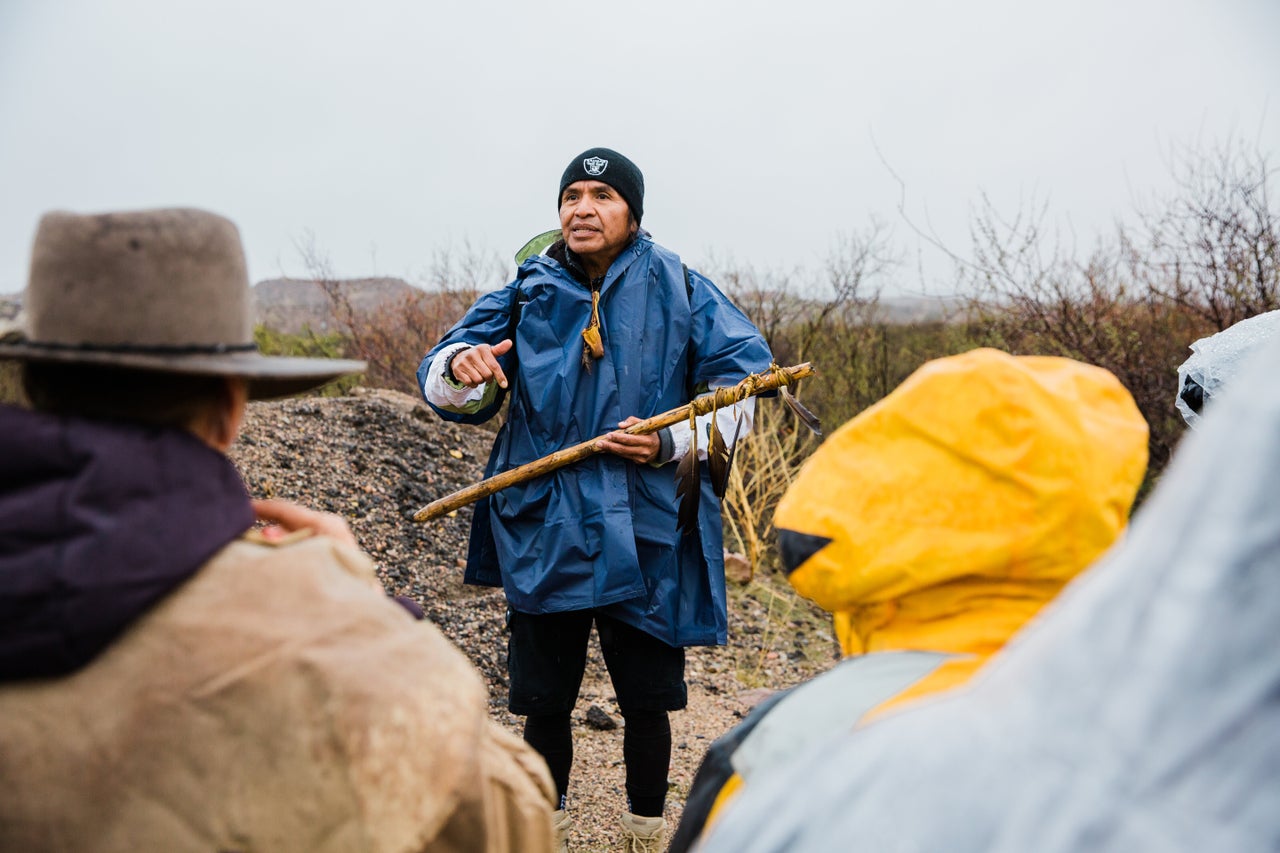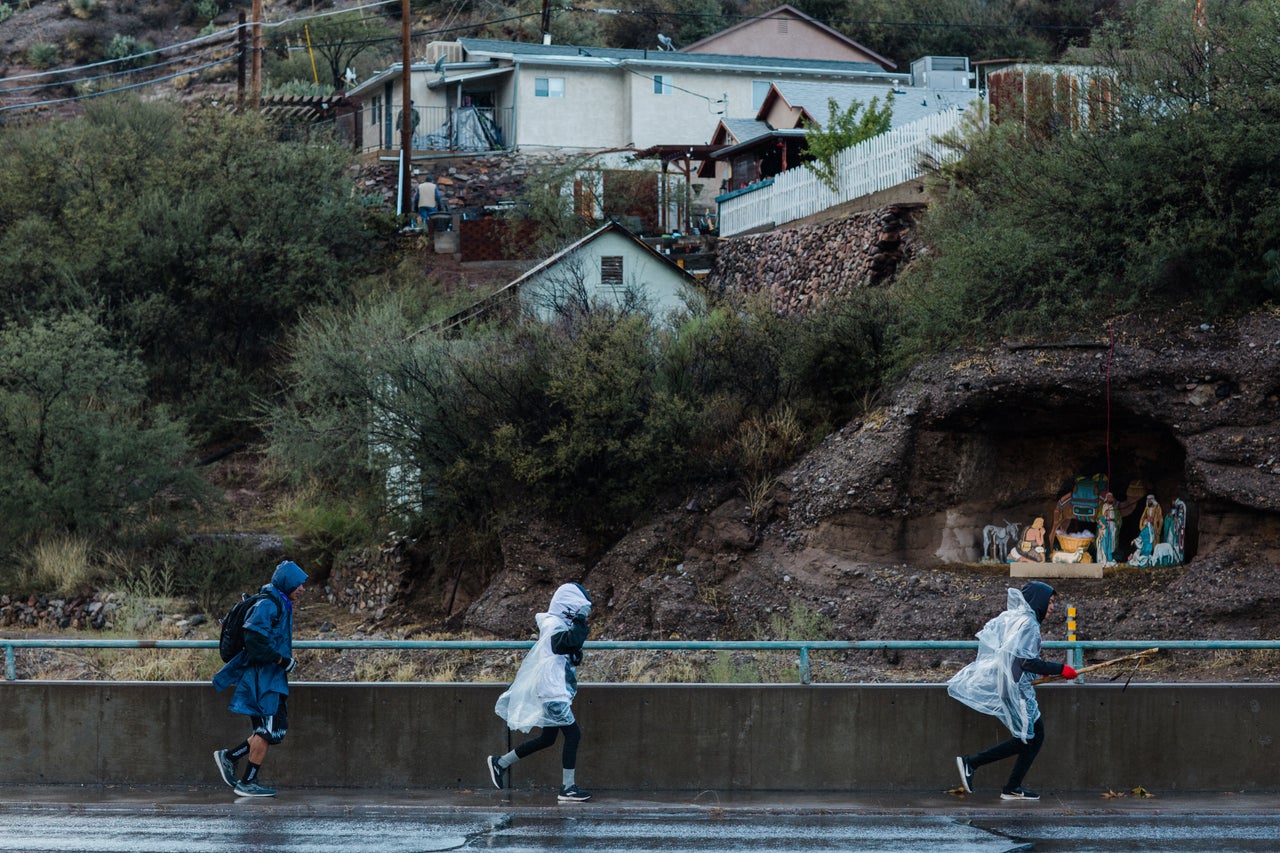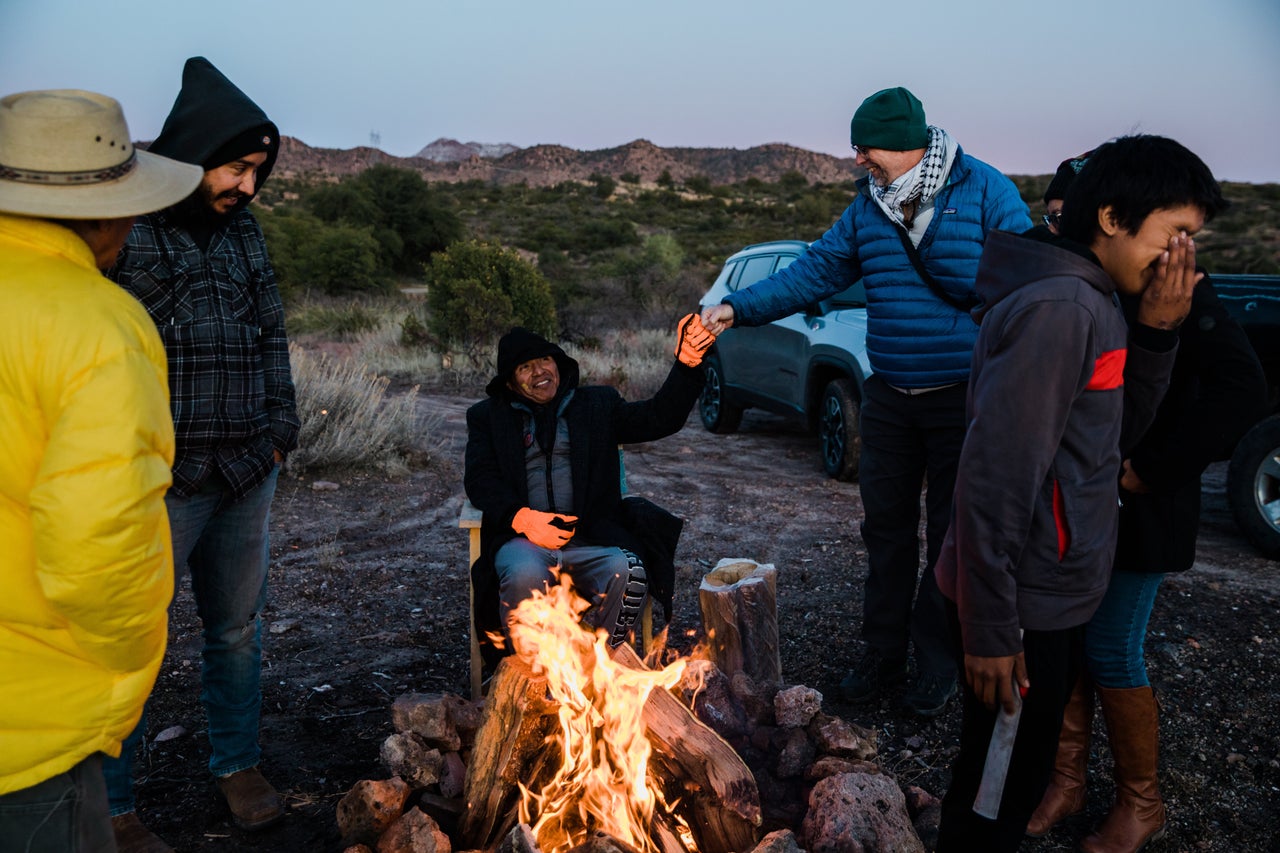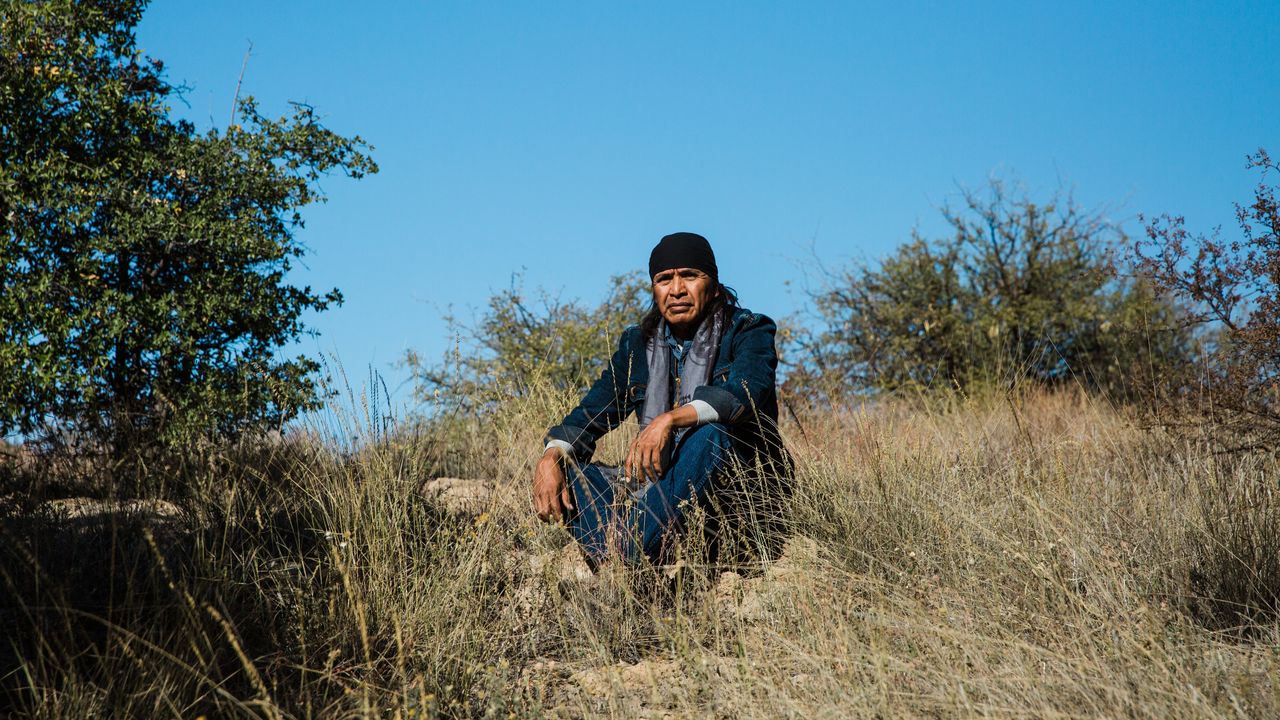Some of Wendsler Nosie Sr.’s earliest memories are set in Arizona’s Tonto National Forest.
“I was about 3 or 4 years old,” the now 60-year-old Apache man recalls on a sparkling fall day, sitting beside his granddaughter at a picnic table under a tall oak tree. “We used to stop here at Oak Flat and my mother would pray.”
The Oak Flat area, which lies within the national forest, is sacred to the Apache people and central to the tribe’s origin story. For centuries before European settlers came, young girls gathered at this place ― called Chi’chil Bildagoteel in Apache ― for their coming-of-age ceremony. Apaches still visit in the spring to collect medicinal plants and in the fall to harvest Emery oak acorns, a protein-rich staple.
But if Resolution Copper, a subsidiary of international mining giants Rio Tinto and BHP Billiton, gets its way, a large part of the site will disappear forever, sinking into a hole two miles wide and deep enough to hold three Statues of Liberty stacked on top of one another.
Nosie nods toward the manzanita and agave plants that ring the Oak Flat campground, the finches flitting between branches overhead, the truck-sized boulders (some covered with petroglyphs) and the deep pools of the Ga’an Canyon river where the Apache deities live.
“They’re going to murder this place,” he says.
This wasn’t supposed to happen.
In 1955, the Eisenhower administration placed Oak Flat off-limits to mining. Then in the early 2000s, Resolution Copper began working to strip the area of that protection. Bills to remove the mining ban were regularly introduced in Congress and just as regularly defeated. In December 2014, this congressional version of whack-a-mole came to an end when then-Sen. John McCain (R-Ariz.) engineered a stealth maneuver.
With no hearings or debate, McCain buried Resolution Copper’s take-over deep in a 700-page must-pass bill to fund the U.S. military. The government’s protection of sacred Apache land went the way of so many other broken promises.
But Nosie’s granddaughter, Naelyn Pike, remains defiant.
“We’re Apaches,” says the 20-year-old. “We’re warriors. The Spaniards and the United States government fought us here. They think they won but they didn’t. The war never ended.”

Five days later, after I met with Nosie and Pike, the tribal council for the San Carlos Apaches held a hearing on Resolution Copper’s plan. Oak Flat is 40-some miles from their reservation, but as councilmember Tao Etpison observed dryly, “We’re not the ones that decided this is going to be our reservation. Arizona is Apache land.”
The purpose of the Nov. 22 hearing, ostensibly, was for federal officials to present and summarize the findings of the draft environmental impact statement required for the mining project. That purpose was a sham, however: McCain’s legislation directed the government to hand over Oak Flat regardless of environmental impact.
The real drama came when council members, one by one, declared their opposition to the mine. Some cited potential damage to their water supply, others pointed to the threatened destruction of habitat. But they all shared a common theme: The plan for Oak Flat violates their religious rights.
“We need to continue to live the teachings of our ancestors,” Tribal Chairman Terry Rambler told the crowd seated in the council chamber. “We Apaches were put on this earth to be that equilibrium. Where one part wants to go out and destroy something ... we say, ‘No, that’s not good for you, that’s not good for your children.’ And that’s who we’ll always be as Apaches.”
The council voted unanimously to oppose the mine and the crowd cheered. Afterward, Sandra Rambler, a diminutive elder (and sister of the chairman) delivered an impassioned speech in Apache. Several people nodded vigorously as she spoke. A few cried. When Rambler sat down, I asked her to repeat what she’d said in English.
She explained that Resolution Copper had bought up parcels of land scattered across southern Arizona to trade for Oak Flat. The company paid a few million dollars for them, but it stands to make tens of billions from the mine.
But there are no ceremonial sites on those other lands. “There’s no holy ground there, so how can we worship?” Rambler said, her voice trembling.
The Apaches aren’t standing alone in the fight for Oak Flat. In 2015, the National Congress of American Indians, the largest and oldest organization of tribal governments, called on the federal government to rescind the “land-swap.” Over the years, support for that idea has grown. After tribal representatives twice addressed the United Nations, indigenous groups around the world pledged their backing.
A host of non-native groups, from the Sierra Club to the Poor People’s Campaign, have also united behind bipartisan legislation to rescind the McCain rider. Rep. Raul Grijalva (D-Ariz.) introduced the most recent version of the Save Oak Flat Act in January 2019, and the companion Senate bill’s sponsors include presidential candidates Bernie Sanders (I-Vt.), Elizabeth Warren (D-Mass.) and Cory Booker (D-N.J.).
“We have a way to win,” said Vanessa Nosie, Wendsler’s daughter. People need to call their representatives in Congress, she said. She’s also calling on a higher power: “We are a spiritual people. We have a strong holy tie to the land. So now we pray.”

Before dawn on Thanksgiving Day, Wendsler Nosie pulled on black leggings, shorts, shirt and sweatshirt and laced up a pair of gray Brooks running shoes. The former San Carlos Apache tribal chairman was entering what he calls “ceremonial mode.”
Nosie was setting out to run from the San Carlos Reservation to Oak Flat, 40-some miles away. And he didn’t plan to leave once he got there.
“I’m going home,” he said.
The journey began with a religious ceremony at the Old San Carlos Memorial, overlooking the lake formed in the 1920s by Coolidge Dam, which flooded an Apache cemetery. As he ran, Nosie carried a prayer stick made from a yucca stalk with four eagle feathers attached. It brings with it the prayers he’d offered at other sacred sites: Bears Ears National Monument in Utah, Standing Rock in South Dakota, the Poor People’s Campaign March on Washington in 2018.
A small group, mostly family members, accompanied him. By the time they reached the boundary of the reservation, clouds had rolled in and a bitter-cold rain was falling. The group paused to pray, walking off the road to the foot of a small mountain. Nosie used his hands to scoop out dirt and create a small pool. He took off his shirt and washed himself with the rainwater, to cleanse him of his hurt and fears and to help him embrace who the Creator made him: an Apache, free from the false encumbrance of colonialism.

“I’m done being a victim,” he said, “done negotiating with lies.”
He redressed quickly and continued his run, away from the reservation he calls a prisoner-of-war camp ― which it originally was ― and toward his ancestral home.
The journey took three days because Nosie stopped often to pray. At one stop, Rev. William Barber II, a leader of the new Poor People’s Campaign, joined the group in prayer.
“We’re standing with our brother Wendsler,” Barber had told me the day before. “He stood with us. You have to understand: Oak Flat is their Jerusalem. What [Resolution Copper] wants to do to Oak Flat is like a fresh crucifixion.”
After he ran through rain, hail and snow, the sky was mostly clear when Nosie neared Oak Flat midday on Nov. 30. About two dozen people lined the highway, welcoming him with scattered applause and cheers. For the most part, however, the moment was more solemn than festive as Nosie crossed the highway and entered Oak Flat.
“I’m home,” he said.

The next day Nosie and I sat out of the wind in the cab of my pickup truck parked near his tent. I asked him what it was like waking up there for the first time that morning.
“Oh, man,” he replied, his face lighting up. “I got up before the sun came and said my prayers and just sat there and watched. It was so beautiful and just awesome to be home. Just hearing the birds, the whispering of the trees from the wind, and the coldness over my body and ...” He paused, searching for just the right words to convey the significance of that moment. He smiled. “And I’m home.”
Nosie had no plans for what comes next. He said he’d stay at Oak Flat and listen to what the deities tell him to do. But ultimately, the fate of Oak Flat is out of his hands. He’s completed his journey.
Before leaving Oak Flat, I asked Nosie what message he wanted readers to take away from the article I would write. He considered it carefully before speaking.
“I want people to know that if we all stand together, we can fix this. We can begin to heal and really develop our leaders with a new mission — and that is to protect what’s left so that our children will have the opportunity to live.”
